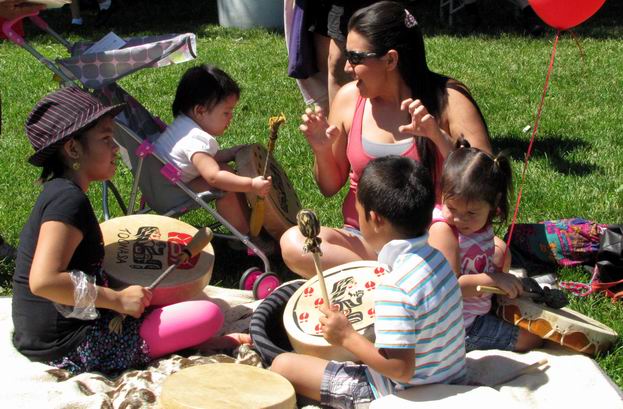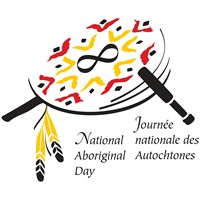National Aboriginal Day

Candace George leads young relatives (aged 2-9) in a song and drumming lesson at Fort George Park. – Photo 250News
Prince George, B.C. – Today is National Aboriginal Day and it will be celebrated at Fort George Park throughout the day with entertainment, food and displays.
Premier Christy Clark says National Aboriginal Day “is a day for Canadians to come together and recognize and celebrate the unique heritage, cultures, and contributions of First Nations, Inuit and Métis Peoples.” She encouraged everyone to be involved in celebrations “"I hope all British Columbians will take the opportunity to celebrate the living culture of Aboriginal Peoples. There is a huge diversity of  Aboriginal traditions and experiences, each truly unique and inspiring."
Aboriginal traditions and experiences, each truly unique and inspiring."
The B.C. Law Society has marked National Aboriginal Day with the announcement of a new mentoring program. Called the Aboriginal Lawyers Mentorship Program, it will see experienced lawyers paired with Aboriginal lawyers who have been practicing for fewer than three years.
Aboriginal people are underrepresented in the legal profession and the Law Society believes strong mentoring is a positive step towards increasing their numbers within the profession.

Comments
Today is also the beginning of summer, so happy summer time.
The aboriginal languages play a key role in their national identity and the majority of those languages are now endangered. They are not alone in the world and even Gaelic speakers in highland of Scotland are now in decline.
MacKinnon 1995 has looked into the decline of Gaelic in Scotland and the 1991 census showed that only 72.6% of those children living with two Gaelic-speaking parents spoke Gaelic, 37.6% of those living with a lone Gaelic-speaking parent, and a mere 14.3% of those living with two parents, only one of whom spoke Gaelic.
I haven’t seen any similar statistics on the situation of first nation languages and such data are vital for language policy makers. How many percentage of children living with two Carrier speaking parents speak Carrier in BC? How many % living with one parent who speaks Carrier can speak it?
Similar statistics by MacKinnon for Welsh and Irish Gaelic have shown that the related numbers are higher than the Scotish Gaelic speakers and the Gaelic chance of survival in Scotland weaker.
What about comparison between Carrier, Cree, Haida, Tsimshian and Salish rates? Unfortunately the UNBC 2004 proposal for first nation languages which could have given us answers to these questions have been blocked for almost a decade. On this national day, it is time for UNBC president to remove the existing barriers in front of research in first nation languages.
With regard to Carrier, the sad fact is that there are NO known child speakers. The youngest fluent speakers who can be identified with certainty are in their twenties. (I know of one possible case of a teenager but have not verified it.) There are so few speakers of child-bearing age that it is meaningless to look at rates of transmission to their children.
The situation is essentially the same for nearly all of the First Nations languages of BC: the great majority have NO young speakers. Plains Cree and Slave are nominal exceptions because these languages are also spoken outside of BC and still have child speakers elsewhere. Otherwise, the language in best shape is Shuswap, which has young speakers primarily due to Chief Atahm School in Adams Lake, which is a 100% immersion school. With the possible exception of Cree and Slave, the number of families in which children are learning a First Nations language as their home language can be counted on one hand.
Nor is much second-language learning going on. Many schools have aboriginal language classes, but their effect is negligible. To my knowledge, no child in BC has ever acquired any real competence in an aboriginal language through an aboriginal language-as-second-language class. Typically the kids learn the names of the more popular animals, the numbers 1-10 (of which they actually remember the first four or five), the colours, some weather vocabulary, a few culturally important words, some songs, and a few memorized phrases and ritual exchanges (of the “How are you: I am fine.” variety) and that’s about it. When I say “no real competence”, I’m not talking bout fluency. I mean that they acquire virtually no ability to produce or understand any sentence that they have not memorized.
There are a few good adult programs, e.g. the Musqueam classes offered by UBC, but university-level classes are often ephemeral, don’t last long enough (i.e. run only one year or one semester), or simply don’t measure up.
The documentation available is also a problem. It varies considerably from language to language, but overall, very few of the FN languages can be said to be adequately documented. Only about half of the languages have a reasonably adequate grammatical description, and only about a third have a reasonably good dictionary. There is, moreover, no systematic effort to remedy this.
I don’t know what the 2004 initiative was, but UNBC has never made an effort to play a serious role in the FN language area. UNBC offers some FN language courses and has run some teacher training programs, but makes no real contribution to research, documentation, or the development of teaching materials, offers no expertise on language maintenance and revitalization, and does not train people to do these things. It’s a real shame.
Musi to the many elders and leaders in our community who help to celebrate and preserve First Nations culture and language. My gratitude to you all.
The 2004 Initiative was a proposal to use CALL technology for teaching of first nation languages to their childrens to help education and transmission rates. A copy was given to the Canada Governor General Clarkson (and UNBC president Charles Jago), when she visited UNBC. I am sure you can get a copy of it from Dr Marilyn Iwama, wife of current UNBC president.
There is a reference to your 1999 work on documentation of BC native languages which might have ticked off Jago, but I am not sure why Iwamas not supporting it.
Ah, interesting. Where did it come from? That is, it sounds like it didn’t come from UNBC if a copy was given to Jago.
Just speculating, I can imagine Iwama being sympathetic in principle but concerned by the lack of an institutional home and relevant faculty.
I am not sure how mad Jago became when he saw your work in the reference section of the proposal. But I bet Marilyn can tell you more about the fate of proposal in UNBC and the fate of the PI faculty in UNBC.
But I can hear the elders singing this eagle song:
Once upon the time,
an eagle rose in the sky
He looked down from that high
when an arrow struck his thigh
Like a fish he fell from that high
He looked at the arrow piercing his thigh, An eagle feather attached to arrow brought his sigh:
âWhy should I complain and sigh?
My feather in the arrow brought me down from that high!
From us brought us down, sigh and sigh!
I will enquire about this, thanks.
An interesting puzzle.
Any Romans at UNBC missing speaking Latin?
What’s up with this event when it shuts down before four and here it was advertized that it would run till six??? Some people work and would like to take in this event after work and when they get there, they announce that it’s over..
Comments for this article are closed.